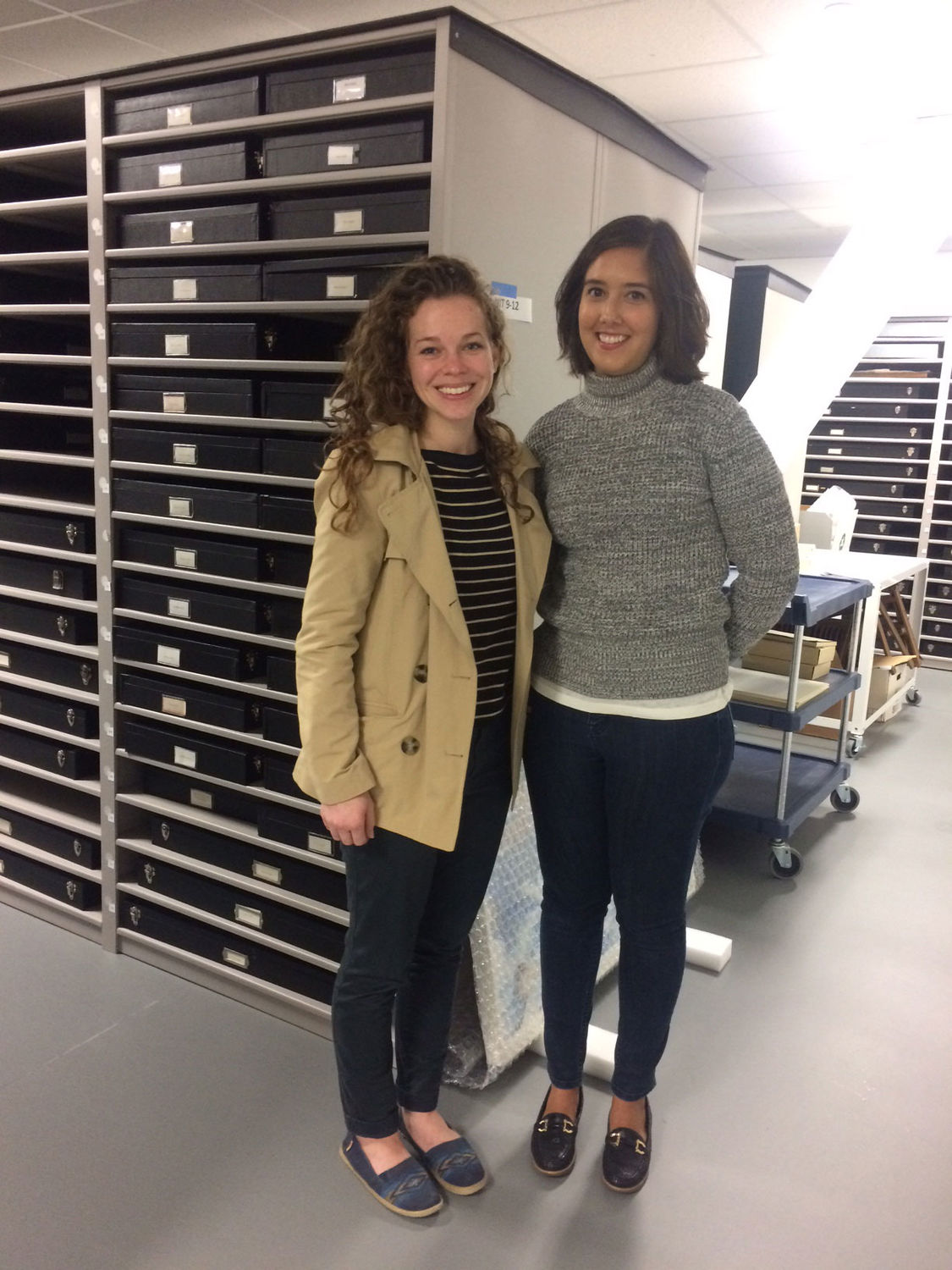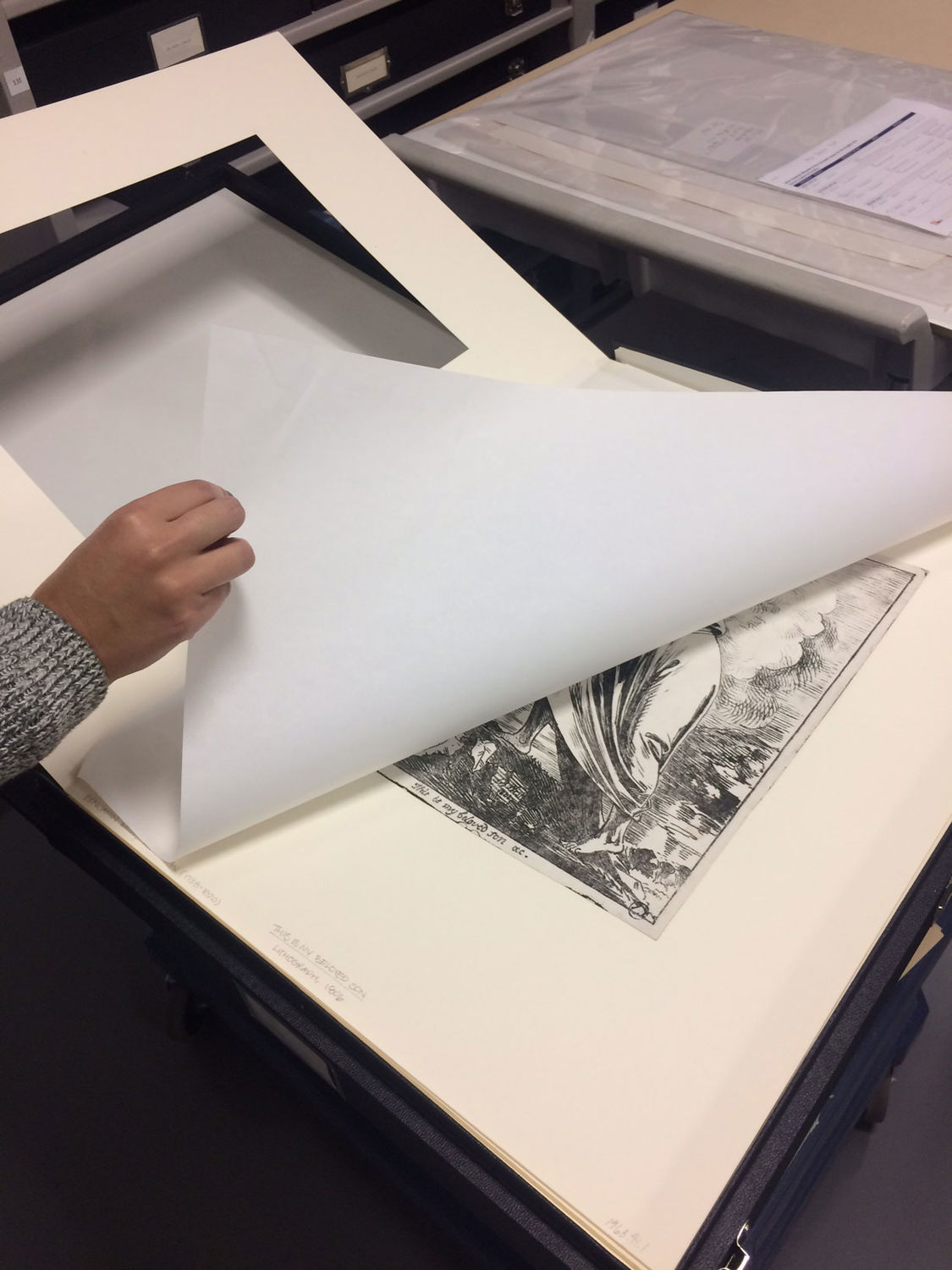
Behind the Scenes in the Registrar Department
“Is this a contemporary art museum?” I overheard a visitor ask the other day, while looking at the colorful mural by Nicolas Party spanning our Lobby Wall. This is a difficult question to answer succinctly, considering the Hammer’s dynamic collection of prints, paintings, drawings, photographs, and sculptures, which ranges from the sixteenth century to the present and imparts varied techniques and artistic traditions from all over the world. Our five collections contribute to the Hammer’s unique identity—a museum where you might find a European Old Master painting just up the stairs from a surreal contemporary sculpture. While the curatorial team organizes our exhibitions, the registrar department ensures the longevity of the Hammer’s collection for future generations of visitors—a task which is no small feat.
I met with Alex Bancroft, assistant registrar, and Haley Di Pressi, registrarial assistant, to gain a new understanding of this department. From traveling across the Atlantic on a cargo plane with an artwork, to “tucking in” prints in their storage boxes like babies, Alex and Haley shared what it’s like to work as registrars at the Hammer.

Mia Lewis: What interested you in working in museums, and in the registrar department specifically?
Haley Di Pressi: I was an intern in the registrar department, and I was hired right after I graduated with an art history degree. I got lucky since I had applied for the internship during my last year at UCLA, and there was an opening right before I graduated. I’ve been here full time for just about a year and a half.
Alex Bancroft: I was a graduate school intern in the curatorial office, and the Hammer was hiring around the time I graduated. I was a collections assistant for a year (which included curatorial work and registration), and then I moved up to my current position.
What was your internship like?
HDP: [My supervisor] Susan walked me through the different aspects of being a registrar. She taught me specific terminology for condition reports, and I helped her pull works from storage. The first time I got to touch a Degas was my favorite moment of being an intern. During exhibitions Susan also let me shadow her in the gallery so I could learn how to unpack, re-pack, and install artworks.
Once we acquire an artwork, what is your department’s role?
AB: Our department is responsible for documentation. When we receive artworks, we do incoming condition reports, which means taking notes on the packing, looking at the condition, and taking pictures. Once finished, we then we re-pack them into long-term storage—typically a crate or box.
HDP: We keep matted prints in Solander boxes. The Grunwald Center Collection has about 40,000 prints, and most of them are in these boxes.

Is the collection still expanding?
HDP: Yes, we receive donations and make purchases every year.
AB: We use archivally-safe materials for the long-term preservation of the works. They all get stored very neatly in a pile.
How does the permanent collection factor into your everyday roles here? Is the collection frequently changing or moving around?
HDP: When the Armand Hammer Collection was on view at The Huntington Library this fall, we worked on it as an outgoing loan. I worked on the logistics, paperwork, and shipment schedule. Most of the permanent collection is not on view, but rather in storage. The Hammer has five collections: Grunwald Center Collection, Armand Hammer Collection, Hammer Contemporary Collection, Armand Hammer Daumier and Contemporaries Collection, and the Franklin D. Murphy Sculpture Garden.
AB: Out of those departments, only a couple are still collecting new acquisitions. The Hammer Contemporary Collection and Grunwald Center Collection are big focuses right now. The permanent collection registrar is in charge of handling all the logistics for new acquisitions, whether they be donations or purchases. That includes working with donors, doing paperwork for purchases, and coordinating with galleries. So it keeps us busy!
What is your favorite part of your job?
AB: We get to work very closely with artists. It is exciting to learn more about their processes and to get to know them personally, which makes the art that much more interesting to me.
HDP: It is really special when you can talk to an artist during installation and ask, “What does this mean?” or “What’s your take on this?” I also like that the Hammer is part of UCLA, so we have a strong commitment to teaching and learning.
What is something most people wouldn’t know about this department?
HDP: The registrars are able to travel with artworks—at least here at the Hammer. I recently went to Washington, D.C. to oversee the installation of Kristen Morgin’s unfired clay piano—a large work that is extremely fragile.
AB: I went to Amsterdam with a large artwork on a cargo plane. That was kind of its own adventure!
What kind of knowledge did you take from being an art history major that transferred over to this position?
HDP: Even though I don’t necessarily have to identify what constitutes a good example of Impressionism for my job, it helps to be passionate about art and enjoy looking at it. Sometimes it feels like when we put works in storage we’re tucking them in—putting them safely back in their home.
AB: When the works are unframed I feel like they are naked and we have to protect them (laughs). They are so vulnerable.
What kind of advice can either of you offer for people who are interested in working at a museum?
AB & HDP: Internships, definitely. Or even volunteering.
AB: When I got out of undergrad, it was hard to get a job in general—let alone in museums. I went to graduate school for library science, which is how I ended up here. My program encouraged internships, and I did as many as I could to figure out what kind of career I wanted to go into. Internships really help solidify where your interests are, and you are able to make invaluable connections through networking.
HDP: Market yourself, and find a way for your skills to apply to the job you want. I volunteered at the Fowler Museum’s welcome desk, and then I came to the Hammer experience the behind-the-scenes aspect of museums. At UCLA I minored in digital humanities, so knowing how to work with databases and having experience with Excel was helpful. Excel is our best friend; it’s how we keep track of everything.
Can you talk about one of your favorite experiences since being here at the Hammer?
AB: I started interning here in 2009. The museum was so different then. There was no Welcome Desk or Visitor Experience staff. Seeing how much it has grown—including more student involvement through Visitor Experience Representatives and an internship program—is thrilling.
HDP: My favorite experiences are standing in the galleries and watching artworks get unpacked for the first time. When I was an intern I was here on de-install day for the Robert Heinecken exhibition. The gallery looked so different—there were crates everywhere, and people were working to pack up all of the photographs. I got to see the inner-workings of the museum, and that was what really hooked me. That was the day I decided this is what I wanted to do.




